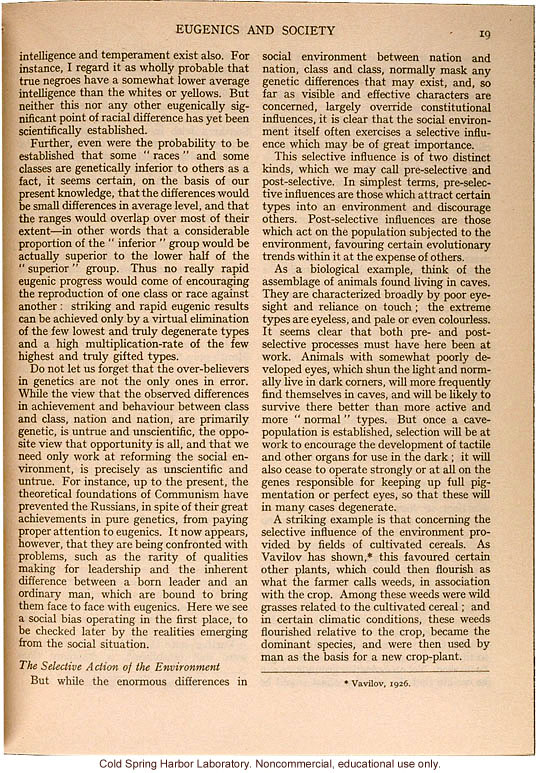Eugenics and Society 19
intelligence and temperament exist also. For instance, I regard it as wholly probable that true negroes have a somewhat lower average intelligence than the whites or yellows. But neither this nor any other eugenically significant point of racial difference has yet been scientifically established.
Further, even were the probability to be established that some "races" and some classes are genetically inferior to others as a fact, it seems certain, on the basis of our present knowledge, that the differences would be small differences in average level, and that the ranges would overlap most of their extent - in other words that a considerable proportion of the "inferior" group would be actually superior to the lower half of the "superior" group. Thus no really rapid eugenic progress would come of encouraging the reproduction of one class or race against another: striking and rapid eugenic results can be achieved only by a virtual elimination of the few lowest and truly degenerate types and a high multiplication rate of the few highest and truly gifted types.
Do not let us forget that the over-believers in genetics are not the only ones in error. While the view that the observed differences in achievement and behaviour between class and class, nation and nation, are primarily genetic, is untrue and unscientific, the opposite view that opportunity is all, and that we need only work at reforming the social environment, is precisely as unscientific and untrue. For instance, up to the present, the theoretical foundations of Communism have prevented the Russians in spite of their great achievements in pure genetics, from paying proper attention to eugenics. It now appears, however, that they are being confronted with problems, such as the rarity of qualities making for leadership and the inherent difference between a born leader and an ordinary man, which are bound to bring them face to face with eugenics. Here we see a social bias operating in the first place, to be check later by the realities emerging from the social situation.
[italics]The Social Action of the Environment[end italics]
But while the enormous differences in social environment between nation and nation, class and class, normally mask any genetic differences that may exist, and, so far as visible and effective characters are concerned, largely override constitutional influences, it is clear that the social environment itself often exercises a selective influence which may be of great importance.
This selective influence is of two distinct kinds, which we may call pre-selective and post-selective. In simplest terms, pre-selective influences are those which attract certain types into an environment and discourage others. Post-selective influences are those which act on the population subjected to the environment, favouring certain evolutionary trends within it at the expense of others.
As a biological example, think of the assemblage of animals found living in caves. They are characterized broadly by poor eyesight and reliance on touch; the extreme types are eyeless, and pale or even colourless. It seems clear that both pre- and post-selective processes must have been here at work. Animals with somewhat poorly developed eyes, which shun the light and normally live in dark corners, will frequently find themselves in caves, and will be likely to survive here better than more active and more "normal" types. But once a cave-population is established, selection will be at work to encourage the development of tactile and other organs for use in the dark; it will also cease to operate strongly or at all on the genes responsible for keeping up full pigmentation or perfect eyes, so that these will in many cases degenerate.
A striking example is that concerning the selective influence of the environment provided by fields of cultivated cereals. As Vavilov has shown,* this favoured certain other plants, which could then flourish as what the farmer calls weeds, in association with the crop. Among these weeds were wild grasses related to the cultivated cereal; and in certain climatic conditions, these weeds flourished relative to the crop, became the dominant species, and were then used by man as the basis for a new crop-plant.
[hairline column-width rule, right side]
[footnote]*Vavilov, 1926.
[end]


